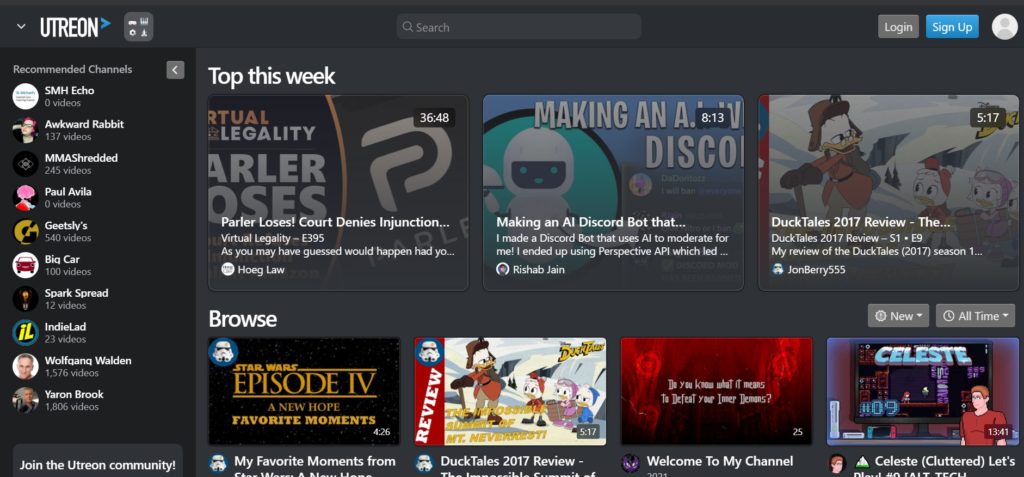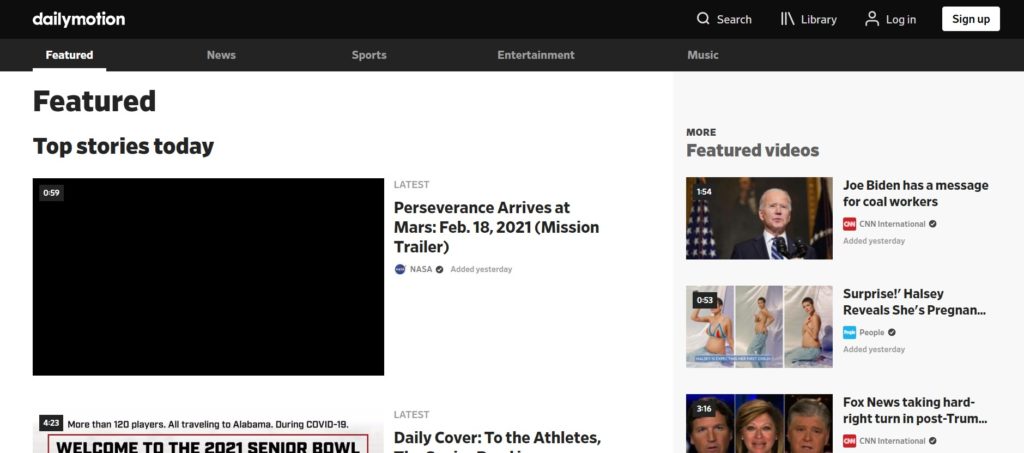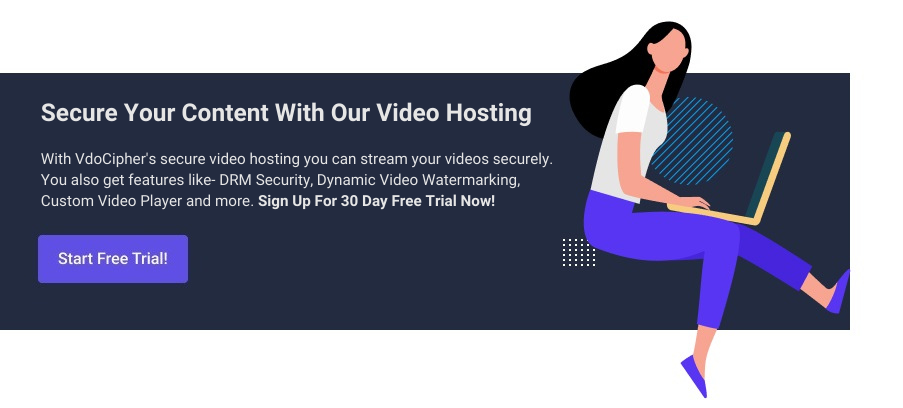Content is the heart and soul of the internet. Users thrive on consuming information that sparks their interest in the most interactive way. Speaking of which, since the onset of the digital era, videos have been making their way through the top content users view on a regular basis. In fact, YouTube, the second largest website across the globe is the largest video sharing platform.
According to WordStream, readers retain only 10% of a message while reading as compared to 95% while watching a video. Combine that with a dependable and fast internet connection and you have a plethora of content flowing in your direction! This gives content creators a golden opportunity to showcase their knowledge and creativity to viewers from all over the world.
Now we know that YouTube has got it all in terms of information and entertainment. But it’s not the only video sharing platform worth mentioning. YouTube alternative sites are just as good!
I’m going to list the top 16 video sharing sites that offer impeccable streaming and uploading capabilities. They’re beneficial for both viewers and creators. In other words, they’re also great video upload sites. But before diving into the details, I’ll highlight some key benefits a video sharing platform offers. Let’s dig in.
TABLE OF CONTENT
What Benefits Does a Video Sharing Platform Offer?
The biggest benefit of video sharing websites for viewers is that they can gain access to broad categories of videos within seconds. On the other hand, content creators can unleash their creativity on various video upload sites.
Uploading a video to a video platform enables easy embedding on a website such as Wix, Squarespace, Hubspot or Elementor. Videos provide businesses with additional exposure, thus, boosting sales, conversions, and ROI. Video content is by far, the best way to engage with your audience and give a compelling message.
Top 16 Video Sharing Sites
1. Vimeo
Vimeo is the most popular video sharing platform after YouTube. It is also the most common YouTube vs. Wistia alternative out there. Most viewers have been complaining about ads popping up at random times while they are watching a video on YouTube. This problem doesn’t arise on Vimeo. This way, viewers can focus on the content as there are no distractions.
The video sharing platform has a free basic version that offers 500MB per week as the maximum upload limit. Premium users can easily upgrade the limit to 5 GB. Even though the free version has a restriction on the amount of data users can upload, it doesn’t cap the video length.
Unlike YouTube, it doesn’t offer any monetization to creators. However, the tip jar button shows that earnings are based on a model of video on demand. The supported video formats on this YouTube alternative include MOV, WebM, MP4, AVI, MPEG4, WMV, FLV, MPEG PS, and 3GPP. Doesn’t that make Vimeo one of the best video upload sites? The best part is that users can browse for high video quality content for free!
Explore More ✅
Build Your Own Video Platform With VdoCipher
Vdocipher helps Video Platform In over 40+ countries to host their videos securely, helping them to boost their video revenues.
2. Utreon
Utreon appeals to a wide array of users, thanks to the diverse content and easy navigation. Even though the video sharing platform is not as popular as YouTube, it’s definitely less distracting. Another good reason why it’s an effective YouTube alternative is that Utreon doesn’t limit or promote channel discovery, thanks to transparent algorithms.
Currently, it’s one of those video upload sites that offer a subscription system with the help of which users can support the creators whose content they like. Some other innovative features include the ability to create their own series or shows. That includes a table of contents, episodes season, cover art for every video.
3. Dailymotion
The primary reason behind the popularity of Dailymotion as a YouTube alternative is the flexibility in various revenue sharing models. However, the video sharing platform caps file size at 2GB and limits the length of each video to 60 minutes. Just like YouTube, it’s also one of the best video upload sites where creators can upload videos and view can browse content.
The user base is approximately 300 million per month. Thanks to its easy monetization program, users can easily earn decent revenue on the basis of views on their videos. Creators can upload 2 hours of a video each day with a restriction of 10 videos. But on the upside, the platform doesn’t charge content creators to upload.
If you are a pro user, you can easily upload high-quality videos with a 1080p resolution limit. As long as you follow the guidelines, there is no reason you can’t add Dailymotion to your video upload sites list.
4. Metacafe
If short-form content is something that sparks your interest, this video sharing platform is a simple platform facilitating both the browsing and uploading of such content. It’s absolutely free to join Metacafe. It’s a small scale YouTube alternative in which the length of the videos is 90-180 seconds. With 100 MB of the file size limit, users can create short duration videos as long as they follow the guidelines of the platform.
A better explanation for the service type on Metacafe is that it’s similar to Instagram Stories and Snapchat (you can add fun stickers, filters and icons). The only difference is that it’s older and the videos don’t disappear after 24 hours. The target audience for this video sharing platform is people looking for quick tutorials, product reviews, and funny videos.
Creators can’t automatically add videos to Metacafe. After they have uploaded a video, a big community comprising around 80000 volunteers decides whether they should add it to the public channels.
5. TikTok
TikTok is a short-form video platform that has rapidly gained popularity due to its easy-to-use editing tools and algorithm-driven content discovery. Videos on TikTok are typically 15 to 60 seconds long, featuring music, dance, comedy, and various trends. The platform’s “For You” page curates content based on user interests, leading to high engagement. TikTok monetizes through in-app purchases like virtual gifts, brand partnerships, and ads.
TikTok has been the hub for short-form content creators since it came out. This video sharing platform is not only popular among the common masses but among celebrities as well. The best part is that you don’t have to be extraordinarily talented to use it as a YouTube alternative. As long as you can entertain, inform or lip-sync, you’re good to go on video upload sites like this one!
Plenty of creators have been using TikTok for showcasing comedy, sports content, DIY videos, gaming stuff, and so on. Popular content creators often get to earn handsome amounts with brand endorsements, sponsorships, and influencer marketing. There are plenty of free sounds and music at the users’ disposal. This offers the freedom of crafting clips according to your taste.
If you wish to add an X-factor to your videos, the real-time effects and attractive filters facilitate the same. The size limit for content is 72 MB for Android users and 280 7.6 MB for iOS. The app is easily available for download for smartphones and tablets. This makes it one of the most convenient video sharing sites ever!
6. Facebook Watch
Facebook offers extensive video sharing capabilities, supporting both pre-recorded and live videos. Facebook Watch is a dedicated video platform where users can discover videos based on their interests, including original shows and content from creators. Facebook Live allows real-time interaction through live streaming, which has become popular for events, Q&A sessions, and community engagement. Facebook monetizes videos through ad breaks, fan subscriptions, and branded content.
The fact that Facebook has crossed the billion mark in its user base adds to its ever-increasing popularity. Creators, brand pages, and users can easily add their content to a diverse video content catalog.
The feature that makes Facebook watch a great YouTube alternative is the ability to watch videos with friends at the same time. The feed is highly personalized which allows users to easily scroll through their favorite uploads. Apart from the management of subscriptions, creators can access the Facebook creator studio for publishing and moderating video content.
The on-demand content feature is also active in some countries. Not only can the creators insert mid-roll ads in between videos, but they can also take an ad break in the middle of a live video and earn even more revenue. But to fulfill the monetization condition, it’s important to have 1 minute each of 30,000 views in total and a minimum of 10,000 followers. Facebook keeps 45% of the cut for itself and offers creators 55% of the revenue.
7. Twitch
Twitch is a live streaming platform predominantly used by gamers but has expanded to include various types of content, such as music, talk shows, and creative arts. It provides interactive features like live chat and subscriber badges, fostering a strong community vibe. Twitch monetizes through subscriptions, Bits (a virtual good that viewers can purchase to cheer on their favorite streamers), and ads. It’s particularly known for its supportive community and high engagement levels.
Twitch is the humble abode for all gaming freaks across the globe. It streams gaming videos on the web as players get 3500 as the maximum video bitrate. If you are an advanced gamer looking for an opportunity to cash in on its revenue-sharing model, you’re in luck! While the payout isn’t as high as YouTube, you can definitely extra bucks some extra bucks with previously recorded videos.
To be an affiliate for this video sharing platform, you should have a total of 500 minutes of live broadcast counted for the last 30 days. Other conditions include a minimum of three viewers and 7 unique broadcasts along with a minimum of 50 followers.
On the upside, it doesn’t cost a dime to become a Twitch affiliate. This YouTube alternative has 11,000+ content creators partnering with the network. The video formats it supports include MP4, AVI, MOV, FLV, H.264 codec, and AAC audio.
8. TED
The sole objective of TED is to help people learn something new. It’s a great YouTube alternative to educate the audience on any niche. From famous speakers to professionals and the common masses, this nonprofit organization features them all. The talks are usually in the form of podcasts or videos which Spark the audience’s interest almost instantly!
9. Instagram
Just take a stroll down the street and you won’t be able to find many people not scrolling through their Instagram news feed. If I had a nickel for every time someone sent me an interesting Instagram reel, I’d be Filthy rich! Targeted towards smartphone users, this video sharing platform offers entertaining and informative content within the Instagram app.
Instagram, owned by Meta (formerly Facebook), offers several video sharing options. Instagram Stories allow users to post short videos that disappear after 24 hours.Reels, a feature inspired by TikTok, enables users to create and share short, engaging videos. Instagram Live allows real-time broadcasting, often used for interactive sessions and influencer marketing. Instagram monetizes through ads and shopping features integrated into videos.
10. DTube
DTube is a video sharing platform that holds many similarities with Dailymotion and YouTube. It relies on blockchain technology for storing videos, unlike YouTube’s centralized server. This makes the data safe from hackers. Thus, DTube is a great YouTube alternative. Instead of displaying ads, DTube is one of those video sharing websites that offer cryptocurrency revenue to the content creators.
11. PeerTube
Just like its name suggests, PeerTube is among those video sharing sites that offer a peer-to-peer video sharing platform. This means that it doesn’t use a single server like most other video sharing websites. Users can easily host their own servers known as instance. You don’t have to worry about censorship on this platform as creators are free to upload all kinds of videos. But the video library of this video sharing platform is a little scarce due to PeerTube being relatively new.
12. LiveLeak
Unlike video sharing websites, the mainstream news doesn’t cover everything in an event. That’s when video upload sites like LiveLeak come into the picture. In the past, many video creators have posted graphic or controversial content on this video sharing platform which provides complete insight on an incident. The restrictions on video sharing sites like LiveLeak are minimal.
13. 9GAG TV
This video sharing platform enables users to upload pictures, GIFs, and videos. The Hong Kong-based social media site also allows users to upload videos from other social media platforms. Launched in 2008, it has made its way through the top video sharing sites in the world. It offers engaging informational, and entertaining content without any limits which makes it a leading YouTube alternative.
14. Webdew
According to WordStream, readers retain only 10% of a message while reading as compared to 95% while watching a video. Combine that with a dependable and fast internet connection and you have a plethora of content flowing in your direction! This gives content creators a golden opportunity to showcase their knowledge and creativity to viewers from all over the world. To express ideas into visuals, organizations hire the best video production company that produces powerful animated videos.
Now we know that YouTube has got it all in terms of information and entertainment. But it’s not the only video sharing platform worth mentioning. YouTube alternative sites are just as good!
15. YouTube
YouTube, owned by Google, is the largest video sharing platform globally, with over 2 billion logged-in monthly users. It offers a diverse range of content, from educational videos and music videos to vlogs and live streams. Users can upload videos, create playlists, and interact with their audience through comments and live chat features. YouTube monetizes through ads, channel memberships, and Super Chat for live streams, making it a primary income source for many content creators.
16. LinkedIn
LinkedIn, primarily known as a professional networking site, has integrated video content into its platform to enhance user engagement. Users can upload videos directly or share video links from other platforms. LinkedIn video content typically includes educational material, industry insights, product demos, and professional updates. LinkedIn Live, a live streaming feature, allows users to broadcast events, interviews, and webinars to their professional network in real time.
What Factors to Consider While Choosing a Video-Sharing Platform?
Choosing the right video-sharing platform is crucial for maximizing your content’s reach and engagement. Here are key factors to consider when selecting a platform:
1. Audience Demographics:
- Who is your target audience? Different platforms attract different demographics. For instance, TikTok appeals to a younger audience, while LinkedIn is geared towards professionals.
- Geographical reach: Consider the global reach of the platform and where your target audience is primarily located.
2. Content Type and Format:
- Video Length and Format: Platforms like TikTok are ideal for short, catchy videos, whereas YouTube supports long-form content.
- Content Style: Each platform has its own content style and user expectations. Instagram favors visually appealing, creative content, while LinkedIn is more suitable for professional, informative videos.
3. Engagement Features:
- Interaction Tools: Look for features like comments, likes, shares, and live chat that allow audience interaction.
- Community Building: Some platforms, such as Twitch, are excellent for building a strong, interactive community around your content.
4. Monetization Options:
- Revenue Streams: Evaluate the monetization opportunities provided by the platform, such as ad revenue, sponsorships, subscriptions, and fan donations.
- Monetization Policies: Understand the platform’s policies on monetization to ensure they align with your goals and content strategy.
5. Analytics and Insights:
- Performance Metrics: Access to detailed analytics is crucial for understanding how your content is performing and how you can improve.
- Audience Insights: Platforms that provide demographic and engagement insights can help you tailor your content more effectively.
6. Platform Policies and Guidelines:
- Content Policies: Each platform has specific content guidelines and policies that you must adhere to avoid penalties or content removal.
- Community Standards: Ensure the platform’s community standards align with your brand values and content style.
7. Technical Capabilities:
- Upload and Streaming Quality: Check the platform’s support for video quality, upload speeds, and streaming capabilities.
- Compatibility: Consider the platform’s compatibility with various devices and browsers to ensure your content is accessible to a wider audience.
8. Ease of Use:
- User Interface: A user-friendly interface can make content uploading, editing, and management more efficient.
- Support and Resources: Platforms with robust support and resources, such as tutorials and customer service, can help you resolve issues quickly.
9. Integration with Other Tools:
- Marketing and Analytics Tools: Look for platforms that integrate seamlessly with your existing marketing and analytics tools.
- Social Media Integration: Platforms that allow easy sharing across other social media can enhance your content’s reach.
10. Community and Networking Opportunities:
- Collaboration Features: Some platforms offer collaboration features that can help you partner with other creators and expand your audience.
- Networking Potential: Consider the platform’s potential for networking within your industry or niche.
11. Cost:
- Subscription Fees: Some platforms may have subscription fees for premium features.
- Ad Costs: If you plan to use paid advertising, evaluate the cost-effectiveness of ad placements on the platform.
By considering these factors, you can select a video-sharing platform that best suits your content strategy, audience, and business goals.
How to Make Your Videos Perform Better on Video Sharing Platforms?
With millions of videos uploaded daily, standing out on video-sharing sites requires strategy, creativity, and consistency. Here are some tips to help your videos capture attention and engage your audience:
1. Create Compelling Content:
- Unique Value Proposition: Offer content that is unique and provides value to your audience. Whether it’s educational, entertaining, or inspirational, your videos should serve a clear purpose.
- Engaging Storytelling: Use storytelling techniques to make your videos more engaging. A well-structured narrative with a clear beginning, middle, and end can captivate viewers.
2. Optimize Your Titles and Descriptions:
- Catchy Titles: Use attention-grabbing titles that clearly convey the content of your video. Include keywords that your target audience is likely to search for.
- Detailed Descriptions: Write detailed descriptions that provide context and additional information about your video. Include relevant keywords to improve searchability.
3. Use Eye-Catching Thumbnails:
- Custom Thumbnails: Create custom thumbnails that are visually appealing and relevant to your video content. Use high-quality images, bold text, and contrasting colors to attract clicks.
- Consistency: Maintain a consistent style for your thumbnails to create a recognizable brand image.
4. Leverage SEO Techniques:
- Keywords: Research and use relevant keywords in your video titles, descriptions, and tags to improve visibility in search results.
- Hashtags: Utilize hashtags to categorize your content and make it discoverable to a wider audience.
5. Engage with Your Audience:
- Respond to Comments: Engage with viewers by responding to comments and encouraging discussions. This interaction can help build a loyal community.
- Call to Action: Include clear calls to action in your videos, such as subscribing, liking, sharing, or visiting your website.
6. Collaborate with Other Creators:
- Cross-Promotions: Partner with other creators in your niche to reach a broader audience. Collaborations can introduce your content to new viewers and add variety to your channel.
- Guest Appearances: Feature guest appearances to provide fresh perspectives and increase viewer interest.
7. Consistency is Key:
- Regular Uploads: Maintain a consistent upload schedule to keep your audience engaged and coming back for more.
- Brand Consistency: Ensure that your video content aligns with your brand’s voice, style, and messaging.
8. Utilize Video Analytics:
- Performance Tracking: Use the analytics tools provided by the platform to track your video performance. Pay attention to metrics like watch time, audience retention, and engagement rates.
- Content Adjustment: Use insights from analytics to refine your content strategy and create videos that resonate more with your audience.
9. High-Quality Production:
- Good Lighting and Sound: Ensure your videos have good lighting and clear audio. Poor production quality can distract viewers and reduce engagement.
- Editing: Edit your videos to remove unnecessary parts and add elements like music, text, and effects to enhance viewer experience.
10. Promote Your Videos:
- Social Media Sharing: Share your videos across various social media platforms to increase visibility and drive traffic to your channel.
- Email Marketing: Use email marketing to notify your subscribers about new videos and encourage them to watch and share.
11. Participate in Trends and Challenges:
- Stay Current: Participate in popular trends and challenges relevant to your niche. This can increase your content’s visibility and attract new viewers.
- Creative Twist: Add your unique twist to trends to make your content stand out while still being relevant.
12. Build a Community:
- Interactive Content: Create interactive content like live streams, Q&A sessions, and polls to engage with your audience in real-time.
- Feedback: Encourage viewers to give feedback and suggestions for future content. This involvement can help you better understand their preferences and create more appealing videos.
Showcase Your Creativity Across Video Upload Sites
Webinars, tutorials, product reviews, interviews, vlogs, movies, series, animations, explainers, and so on! According to Marketing Charts, the average user spends 100 minutes watching videos online in a day. Doesn’t that automatically make video sharing websites evergreen?
It’s understandable that rolling out unique and fresh video content can be daunting. That’s the reason why despite so many video sharing sites, creators still sit on the sidelines. But once you are familiar with the wants of your audience, a good video sharing platform makes the process a breeze.
However, a major problem for creators sharing videos is piracy. Don’t sweat it. All you need is secure video hosting that prevents unsolicited downloads and captures. It doesn’t matter which software or internet plugins someone uses. So, what are you waiting for? Quench viewers’ thirst for information and accomplish your video goals with the best video sharing sites.
Supercharge Your Business with Videos
At VdoCipher we maintain the strongest content protection for videos. We also deliver the best viewer experience with brand friendly customisations. We'd love to hear from you, and help boost your video streaming business.

Head of Digital Marketing at Vdocipher. I love the art of connecting the right product to their users. When i’m not doing that i love getting lost in books.




